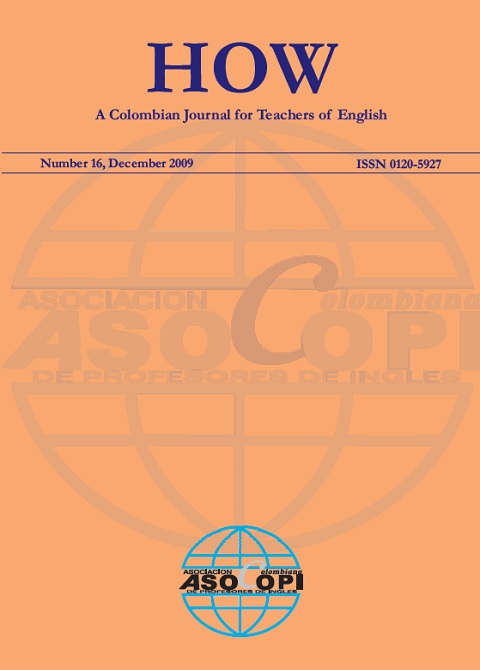Language Policies in Colombia: The Inherited Disdain for our Native Languages
Main Article Content
Abstract
As a contribution to enhance the discussion about the spread of the symbolic power of English in Colombia through a National Bilingual Policy, this paper aims at raising awareness about two main aspects: 1) Colombia has a variety of languages that should be seen as resources and not as problems (Ruíz, 1984) and 2) There is a pattern in our government language policies that tends to favor the elite. The conclusion of this paper is that not much has changed in the linguistic planning in Colombia since the Spanish colonization; privileged groups continue to legislate to favor privileged groups. This approach contributes to enlarge the gap between the haves and the haves not in Colombia.
Article Details

This work is licensed under a Creative Commons Attribution-NonCommercial-NoDerivatives 4.0 International License.
The authors of the manuscripts accepted for publication in HOW journal are required to sign a nonexclusive license agreement allowing ASOCOPI to reproduce the full text on the Internet or in any other available source. Authors retain copyright of their manuscripts with the following restrictions: first publication is granted to ASOCOPI; nonexclusive agreements with third parties can be established as long as the original publication in the HOW journal is properly acknowledged.
References
Colombia Aprende (2008) Cimarrones y cimarronajes. Retrieved from: http://www.colombiaaprende.edu.co/html/etnias/1604/article-82836.html
Constitución Política de Colombia (2000) Retrieved from: http://www.banrep.gov.co/regimen/resoluciones/cp91.pdf
De Mejía, A.M. (2005). Bilingual education in Colombia: Towards an integrated perspective. In De Mejia, A.M. (Ed.), Bilingual education in South America (pp. 48-64). Clevedon: Multilingual Matters Ltd.
Decker, K. & Keener, A. (2001). A report on the English-based Creole of San Andres and Providence Islands, Colombia. SIL International.
Dieck, M. (1998). Criollística Afrocolombiana. In Maya, L.A. (Ed.) Geografía humana de Colombia: Los Afrocolombianos. Tomo VI (pp. 303-338). Bogotá: Instituto Colombiano de Cultura Hispánica.
Dittmann, M. (1992). El criollo sanandresano: Lengua y cultura. Cali: Universidad del Valle.
Forbes, O. (2005). Creole culture and language in the Colombian Caribbean. Centro de Medios independientes de Colombia. Retrieved from: http://colombia.indymedia.org/news/2005/05/25461.php
Grimaldo, J.C. (2007). Programa Nacional de Bilingüismo. Colombia 2004-2019. Talk presented in Bogotá during the “Talleres de apropiación de los Estándares.”
Grimes, B.F. (2000). Ethnologue: Languages of the world. 14th edition. Dallas: SIL International.
Holm, J. (1984). Central American English: Our hemisphere’s best-kept secret. Geolinguistics, 10, 57- 73.
Jiménez, N. (1998). Etnoeducación: Política oficial para la educación en comunidades indígenas. In Trillos, M. (Ed.), Educación endógena frente a educación formal (pp. 59-79). Bogotá, Universidad de los Andes: Centro Colombiano de Estudios de Lenguas Aborígenes.
Landaburu, J. (2005). La situación de las lenguas indígenas de Colombia: prolegómenos para una política lingüística viable. En Amérique Latine Histoire et Mémoire, No. 10-2004 - Identités: positionnements des groupes indiens en Amérique latine , Retrieved from: http://alhim.revues.org/document125.html. Retrieved April 13th 2007.
Lipski, J. (1987). On the construction ta + infinitive in Caribbean “Bozal” Spanish. Romance Philology, 40 (4), 431-450.
Mar-Molinero, C. (2000). The politics of language in the Spanish-speaking world. London and New York: Routledge.
Megenney, W. (1986). El Palenquero. Un lenguaje post-criollo de Colombia. Bogota: Instituto Caro y Cuervo. LXXIV.
McWhorter, J. (1995). The scarcity of Spanish-based creoles explained. Language in Society, 24 (2), 213-244.
Ministerio de Educación Nacional (n/d) La revolucion educativa. Retrieved from: http://www.mineducacion.gov.co/1621/article-85576.html
Morren, R. (2001). Creole-based trilingual education in the Caribbean archipelago of San Andres, Providence and Santa Catalina. Journal of multilingual and multicultural development, 22 (3), 227-241.
Morton, T. (2005). Sociolinguistic variation and language change in el Palenque de San Basilio (Colombia). Doctoral Dissertation. Philadelphia, Pennsylvania: University of Pennsylvania.
Oceanic Linguistics Special Publications, 14 (1975). A Bibliography of Pidgin and Creole Languages. 132-133.
Omoniyi, T. (2003). Language ideology and politics. A critical appraisal of French as a second official language in Nigeria. AILA Review, 16, 13-25.
Patiño Rosselli, C. (1991). Español, lenguas indígenas y lenguas criollas en Colombia. Bogotá: Instituto Caro y Cuervo.
Patiño Rosselli, C. (1992). La criollistica y las lenguas criollas de Colombia. Thesavrvs. Boletin del Instituto Caro y Cuervo. Tomo XLVII (2) 233-264.
Patiño Rosselli, C. (1998). Relaciones de contacto del Criollo palenquero de Colombia. Forma y Función, 11, 77-101.
Patiño Rosselli, C. (2000). Apuntes de lingüística colombiana. Forma y Función, 13, 67-84.
Pineda Camacho, R. (1997). La Constitución de 1991 y la perspectiva del multiculturalismo en Colombia. Alteridades, 7 (14), 107-129.
Pineda Camacho, R. (2000). El derecho a la lengua. Historia de la politica linguistica en Colombia. Estudios Antropologicos No. 4. Bogota: Universidad de los Andes.
Ruiz, R. (1984). Orientations in language planning. The Journal for the National Association for Bilingual Education, 8(2) 15-34
Schwegler, A. (1998). El Palenquero. In: M. Perl and A. Schwegler (Eds.), America negra. Panoramica actual de los estudios linguisticos sobre variedades hispanas, portuguesas y criollas, (pp. 220-291). Vervuert: Iboeroamericana.
Schwegler, A. & Morton, T. (2003). Vernacular Spanish in a microcosm: Kayetano in El Palenque de San Basilio (Colombia). Revista internacional de linguistica iberoamericana, 1 (1), 97-159.
Todorov, T. (1984). The conquest of America. The question of the other. (Richard Howard [Trans.]) New York: Harper & Row, Publishers.

